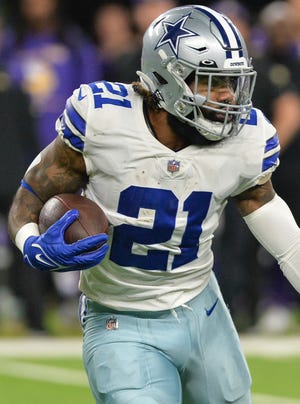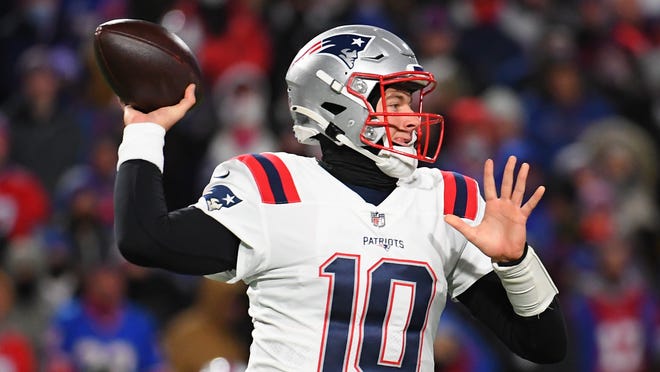FRISCO, Texas — To Ezekiel Elliott, the diagnosis is not important.
Yes, the Dallas Cowboys running back injured his knee more than two months ago in an Oct. 3 win over the Carolina Panthers. Yes, he has battled stiffness ever since that limits his effectiveness, including his explosive ability. His recovery is gradual, Elliott said Wednesday after practice, adding that he is “getting some strength back.”
The Cowboys running back has declined, and continues to decline, to reveal the nature of his injury. He says a report that he suffered a bone bruise is not accurate. Regardless of medical nomenclature, Elliott sees one outcome as certain.
“All I can tell you is I’m going to be out there,” Elliott said. “You’re going to have to drag me off the field.”
It’s an atypical injury approach for a 2021 Cowboys team that has otherwise handled injuries cautiously, holding out players including quarterback Dak Prescott (calf) and Randy Gregory (calf) for what some in the building consider extra time in hopes of maximizing team health and availability for what Dallas (8-4) hopes is a deep playoff run.
Elliott, meanwhile, has yet to miss a game this season even as his — and the Cowboys’ run game — productivity has declined sharply since their September and early October success.
How drastically has Elliott’s knee limited him? And what else contributes to the Cowboys’ decreased run efficiency? USA TODAY Sports examined.
NFL NEWSLETTER:Sign up now to get football news delivered to your inbox

‘I am concerned’
During the Cowboys’ first six games this season, Elliott averaged 86.8 rushing yards per game and 5.11 yards per attempt. He scored five rushing touchdowns. In tandem with fellow running back Tony Pollard, the Cowboys carried a punishing ground attack averaging 164.3 rushing yards per game, second best in the league.
The Cowboys mounted leads that further boosted their ability to run, leaning heavily on their run game with the second most attempts in the league. But production didn’t only stem from an investment of snaps: The Cowboys were also efficient, averaging 5.08 yards per carry (fourth best) and scoring 10 rushing touchdowns (sixth).
After their Week 7 bye, that run game plummeted.
Since their Halloween visit to Minnesota, the Cowboys have fell to 4.1 yards per carry (and far fewer if you take out the rare 58- and 33-yard runs featured vs. the Saints), which ranks 22nd during that stretch. Their 93.7 rushing yards ranks 21st and their early down struggles have yielded third-and-longs the Cowboys too often fail to convert. In Thursday night’s win at New Orleans, the Cowboys defense bailed its offense out on a night where they converted just 2-of-13 on third-down attempts.
“We got to do a better job of finding some more consistency,” offensive coordinator Kellen Moore said. “We’re not going to run the triple-option all of a sudden or anything like that, but you find what kind of little tweaks and adjustments we can make. They may be subtle, but I think they can be very effective if we find the right pieces and make our adjustments necessary to progress.”
Elliott has averaged fewer than half as many yards per game as he did during his first six games (down from 86.8 to 40.6) and says coaches are limiting his touches as he manages the knee injury. His pass protection has still been crucial to Prescott’s success, but his rushing efficiency has been cut a third, his average yards per carry now 3.44. Cowboys head coach Mike McCarthy said Friday that Elliott is “fighting to get back in there every time” but “I am concerned.”
“He’s a warrior,” McCarthy said. “Zeke’s running style is ferocious. He gives a pounding and he takes some hits. We need to evaluate that and this week we’ll see what the preparation looks like for him.”
On Wednesday, preparation for Elliott meant full practice participation, according to the Cowboys’ official pregame injury report. Elliott engaged in an extended “prehab” warmup, as he and fellow sixth-year player Prescott often do, warming up his knee on a stationary bike before joining fundamental drills.
Elliott said the Cowboys’ extended break — with 10 days between their Thursday night game in New Orleans and a Sunday visit to Washington, McCarthy gave the players a full three-day weekend — enabled him to rest and visit physical therapy. Friday MRI results revealing improvement and a prognosis of a more full recovery in three to four weeks, Elliott said.
“Hopefully perfect timing, close to as good as it can be when playoffs are rolling around,” Elliott said. “Just got to do everything we can to make sure we’re continuing to progress that way.
“Playing on it is not making it worse.”
The bigger picture
No doubt, Elliott’s health is a major factor to the Cowboys’ run-games woes. But the lack of offensive rhythm goes beyond him. Time clocks in the passing game, dissonance in offensive line blocking patterns and receiver injuries (for a game and half, the Cowboys were simultaneously down both Amari Cooper and CeeDee Lamb) also contribute. The Cowboys must rediscover the offense that earlier this fall they described as “pick your poison” and “aggressively take what the defense gives us.”
And to some fans’ dismay, increasing Pollard’s touches further is not a sole answer to restoring run stability. There is the difference in their running styles, the 228-pound Elliott is more primed to wear down the interior of a line grinding for runs while the 209-pound Pollard leverages his cutting ability and balance to elude tacklers as he did on a 58-yard rushing touchdown around the perimeter in the fourth quarter vs. the Saints. There are also health implications leading into a division game at Washington: Elliott fully participated in practice and said his injury has not needed and will not need surgery. Pollard was relegated to rehabilitation Wednesday while battling a foot injury. The Cowboys signed an extra running back to the practice squad in case Pollard’s injury lingers.
Immediate availability doesn’t erase the credit Pollard deserves for his career-best 259 rushing yards and 861 total yards from scrimmage. Dallas’ 2019 fourth-round draft selection’s efficiency is elite: Only two running backs with 50-plus carries have averaged more than his 5.6 rushing yards per attempt. At 5.6, Pollard’s mark ties Colts running back Jonathan Taylor, a legitimate MVP candidate.
“His vertical cut run style has been extremely productive, both on offense and in special teams,” McCarthy said of Pollard, who ripped off a 100-yard kick return touchdown on Thanksgiving. “He’s playing with unbelievable confidence. He’s obviously very comfortable schematically.”
So the Cowboys will continue to play Elliott and Pollard as healthy, optimistic that the return of their receiving trio in Cooper, Lamb and Michael Gallup will open up the run game. The running backs are eager to make their mark as the Cowboys face a key stretch to securing their division title and chasing deep postseason hopes. Teammates are optimistic the run game will right its course.
Elliott is “playing through some problems, but I mean that doesn’t really stop him,” Lamb said. “He’s still out there punishing guys on third down, getting the first and just playing bruiser football.”
That’s Elliott’s goal, beginning this week against Washington’s third-ranked (91.3 yards per game) run defense.
“It’s football, you’re never going to be 100{cfdf3f5372635aeb15fd3e2aecc7cb5d7150695e02bd72e0a44f1581164ad809},” he said. “Late in the season, we’re getting a little nicked up but you just got to fight through, push through and figure it out.
“It’s a tough game. I take a lot of pride in being out there.”
Follow USA TODAY Sports’ Jori Epstein on Twitter @JoriEpstein.







More Stories
How To Protect Your Dedicated Server From Brute Force Attacks?
Ways To FInd Out Who Is Hosting A Certain Website?
Mobile Legends Bang Bang: The Ultimate Guide for Players